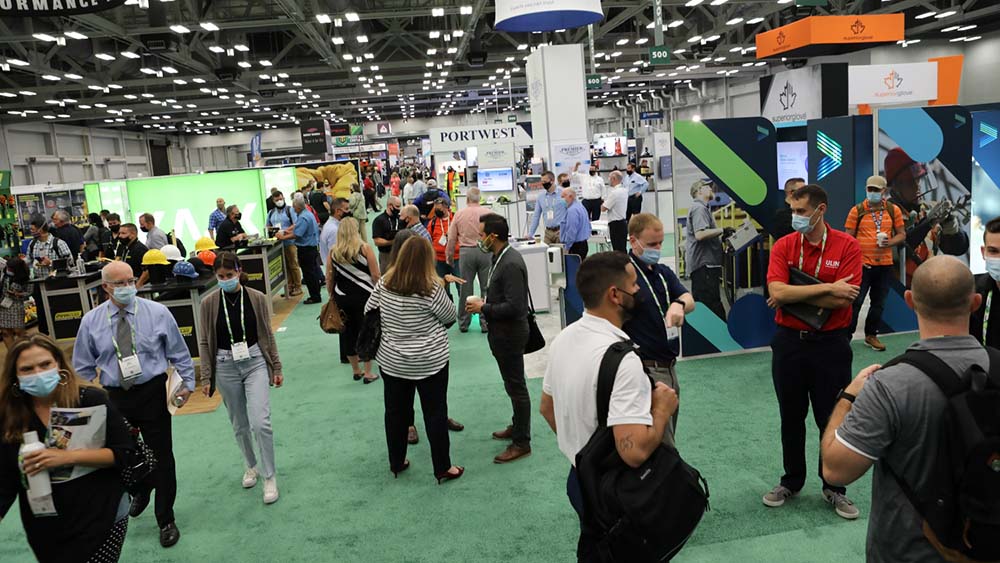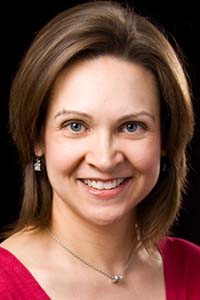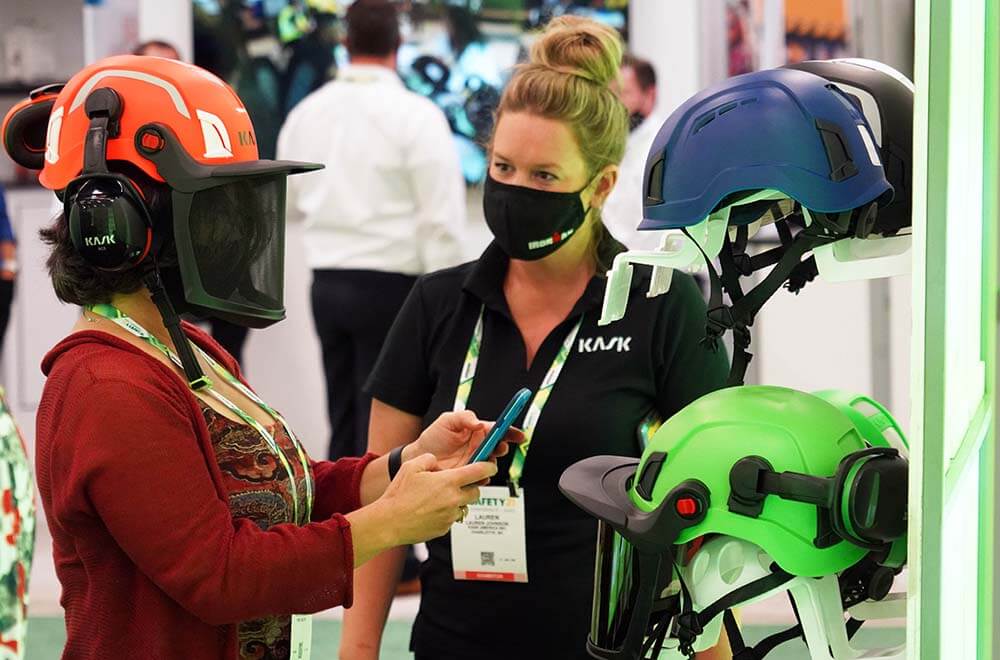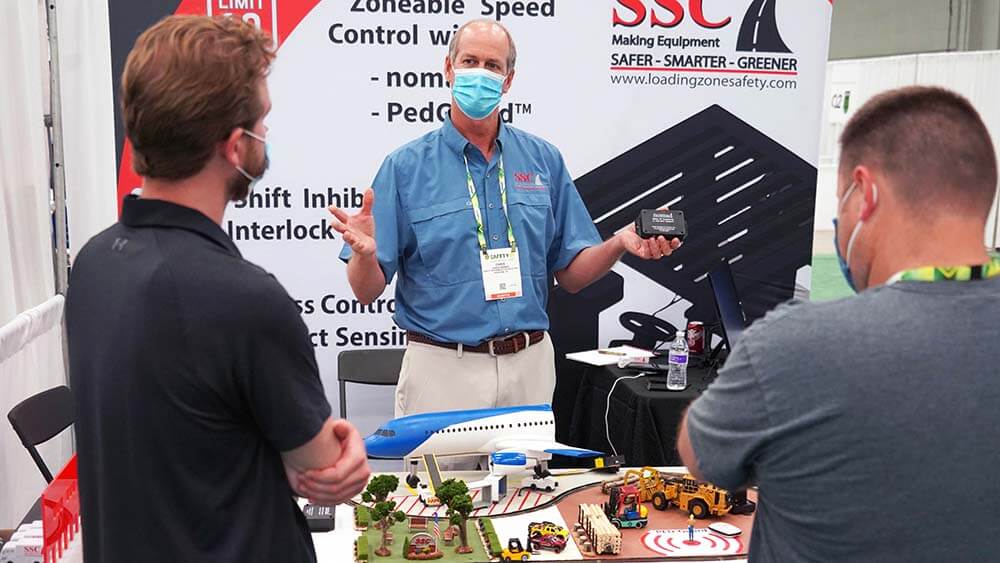
On-site safeguards at the Austin Convention Center for the ASSP’s Safety 2021 Professional Development Conference and Exposition included mandatory face coverings, among other protocol. (Robb Cohen Photography)
When the American Society of Safety Professionals (ASSP) first booked the Austin Convention Center as the site of its Safety 2021 Professional Development Conference and Exposition, COVID-19 vaccinations weren’t widely available and, as planning continued, the Delta variant led to increased cases leading up to the Sept. 13-15 event.
Meeting in person is important to ASSP’s safety and health professional members from across the country. The interactive and collaborative conference offers attendees the ability to earn continuing education units, network with others, and discover products and services.

Lauren Bauerschmidt
“We knew there was a need for the event,” said Lauren Bauerschmidt, CSP, STS, standards development manager for ASSP. “Our annual conference helps safety professionals to keep their workers safe, and obviously that continued through the pandemic.”
From the outset of planning, ASSP wanted to implement a high level of safety protocols for the event. While the ASSP team was constantly monitoring vaccination rates, case rates, as well as local, state, and national regulations, they found a willing partner in Visit Austin to help with planning.
“Even though Safety 2021 was our 60th annual conference, it was ASSP’s first conference and expo in Austin,” Bauerschmidt said. “Working with a group that knows Austin in-depth simplified aspects of our planning.”
In the Q&A below, Bauerschmidt talks about how ASSP and its Austin partners worked together to make its 2,402 in-person participants at its hybrid event — out of a total of 4,993 registered attendees — feel safe in Austin.
Why did your organization choose Austin for the live event?
One reason we chose to have our event in Austin is because we could have the convention center to ourselves, allowing us more control over the safety protocols and the ability to know everybody who was there, so to speak.
How did Visit Austin and the convention center ease your planning load?
It was really a partnership, and they were great partners. If we expressed a need or had a question, we found solutions together since they know their space, they know their city. And the recommendations and advice provided by Visit Austin saved us time and helped us provide attendees with a broader experience.
One example within the convention center that’s COVID-related was seating arrangements. We knew some people might be comfortable sitting close together, and some people might be less comfortable with that and want a little bit more space. So for the general session and for the concurrent sessions the left side of the room was set up with normal seating, and on the right side of the room attendees were seated in every other chair. We worked on that solution with the convention center staff to keep people safe in this new environment.

Safety 2021 by the Numbers
- 4,993 total registrations
- 2,402 in-person registrations
- 2,591 digital registrations
- 2,513 first-time attendees (total)
- 94 percent of responses to post-event survey said they would recommend the conference.
Safety 2021 included and expo with 371 vendor booths.
What were the biggest factors in producing a safe, successful event in the Austin Convention Center?
Developing, communicating, and implementing comprehensive safety and health protocols were the driving factors that made Safety 2021 a success. We required all attendees to provide proof of full vaccination or a negative COVID-19 test within 48 hours of badge pick-up. On-site safeguards included mandatory face coverings, contactless registration, physical distancing, designated entrances and exits, seating limits in meeting rooms, and frequent cleaning of common areas. Food trucks enabled attendees to eat just outside the convention center. Many safety professionals voiced their appreciation of our strong commitment to keeping them safe during a challenging time for public health.
How did you work with the Austin hotels and other venues on the attendee experience?
I’m sure you’ve been to a conference where there’s a huge line at registration to pick up your badge. We wanted to avoid that, especially since we were asking for additional information with the vaccination or test records. So we encouraged people to pick up their badges early, not only at the convention center, but at two of the hotels that had our badge pick-up kiosks in their lobbies. The hotels were very cooperative in helping to facilitate that. Also, we had some concurrent sessions in the hotel that’s attached to the convention center and we had similar physically distanced seating options and those kinds of things at the hotel. So they were great.
Did you have a code of conduct or set of expectations communicated in advance among staff and attendees?
Is that kind of communication well in advance one of the keys to pulling off a safe event?
Absolutely. We are really big on setting expectations. Our attendees and exhibitors knew our expectation was to show proof of vaccination or negative tests, so they were prepared.
What were some other ways you created a safe experience for attendees?
Safety people like to talk about layers of mitigation. If you think of a piece of Swiss cheese with its holes, you want to make sure the holes don’t line up. So, for example, besides the measures already noted, we verified with the convention center that they had the highest level of filtration in their HVAC systems. There were many ways we were keeping people safe, but I would say the vaccination requirement, tests, face coverings, and meals outside were the main ways we did that.

Visit Austin and the Austin Convention Center provided ASSP organizers with recommendations and advice that saved time and improved the experience for attendees. (Courtesy Visit Austin)
With the food-truck meals, did you give attendees plenty of time to go back to their rooms to eat if that’s what they decided?
This was another way the Austin Convention Center helped us. There was a ballroom in the Expo Center that we weren’t using, so they set up scores of well-spaced chairs and tables for people to sit. Obviously it’s hot in Texas in September. If people didn’t want to sit outside, there were places to sit inside physically distanced, but I think people just enjoyed being outside and having that fresh air, taking that little break and then coming back in. And our schedule was designed to give people enough time to do that. Sometimes with conventions you feel like you have to keep running to the next thing, so we built in extra time into the schedule so people wouldn’t feel rushed.
How has the reaction been from attendees to all the safety measures and the code of conduct that you put in place?
Overall, it was really positive. People felt safe and appreciated all the measures we put in place. Our event team received many positive comments during the three-day experience, confirming that we made the right decision in moving forward with the in-person component of the event.
This was a hybrid event. How did Austin help with the hybrid experience?
We didn’t partner with them too much on the virtual side, but I will say that any space we needed, we had great access to it. So let’s say I am actually in Austin and I am speaking in one of the virtual sessions — the convention center provided a speaker prep room, if you will, where virtual speakers could be in that live chat. The convention center was great with anything we needed.
Learn more about how Austin is bringing events back safely at visitaustin.org/meet.

